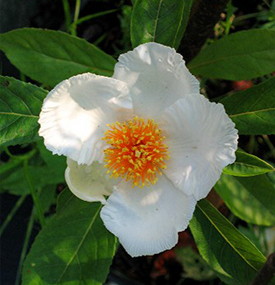 Today my cherished Franklinia finally opened its lovely white blossoms, the last tree to flower each year. It was discovered by plant collector John Bartram in 1770 in Georgia, brought to his medicinal botanic garden in Philadelphia, and never seen again in the wild. He named it after Benjamin Franklin, and every specimen that exists today is from his
Today my cherished Franklinia finally opened its lovely white blossoms, the last tree to flower each year. It was discovered by plant collector John Bartram in 1770 in Georgia, brought to his medicinal botanic garden in Philadelphia, and never seen again in the wild. He named it after Benjamin Franklin, and every specimen that exists today is from his
plant.
It’s slow and hard to grow, but all serious gardeners like a challenge. So when the large blossoms open one cheers, even though it harbingers the end of summer. In a month or so, it will put on its coat of brilliant orange and red to nod farewell for another year.
Their are two other stalwarts of fall that also bloom now if you look. The pale blue aster with its ephemeral frosty hue, like smoke upon the hills. It mingles with the late waving yellow fronds of goldenrod.
In unmowed fields, along neglected roadways and in semi-shaded spots, these tough survivors wave their 4 foot tall flower heads to herald the season’s end. Poor goldenrod has become respectable again. This wild flower was thought to cause hayfever but we now know the culprit is really ragweed.
Today, with our increased ecological sensitivity and less gardening time, we are letting things grow more naturally. This coupled with a romantic trend of cherishing native plants, loved for their ethnicity, has turned these two wild things into garden plants. So we value these two old reliables that seem to pop up from seed, and chug along, despite our neglect.
One can easily collect seed from wild plants. I try to find the bluest asters. (Mine are quite pale.) There are 125 species of wild goldenrod, so I look to collect seed from those with the biggest flower head. Goldenrod holds up well as a cut flower, and retains its yellow, even when dried.
Cut aster however is fleeting and short lived. Though hardy in the fields it is fragile both in vase and in the garden.
Mine do seem to come back each year despite neglect. They are tall and wavy, not for neatnicks. Sometimes they fall over and need to be staked up. Since they are short lived, the seed heads should be left in the bed. The trick is to recognize the small seedlings that sprout in spring and don’t weed them out.
Cultivated improved garden asters are also available, a beautiful perennial for the border. Their deeper color is actually more purple than pure blue, but never mind. Some are tall and some are low. A welcome addition.
But now, in the fields, along the roads, in the back of the garden, or peeking out from under neglected shrubs, the wild asters show their pale faces. Brave little survivors, to share the fall with their goldenrod friends. Pick a few (they are not endangered) or better, collect some seeds and bring them to your garden for next fall. They prefer sun, and sometimes they take two years to come to full bloom.
Ruth S. Foster is a landscape consultant and arborist. Find more gardening advice at her website: www.mothersgarden.net.
Credit: www.mothersgarden.net




























